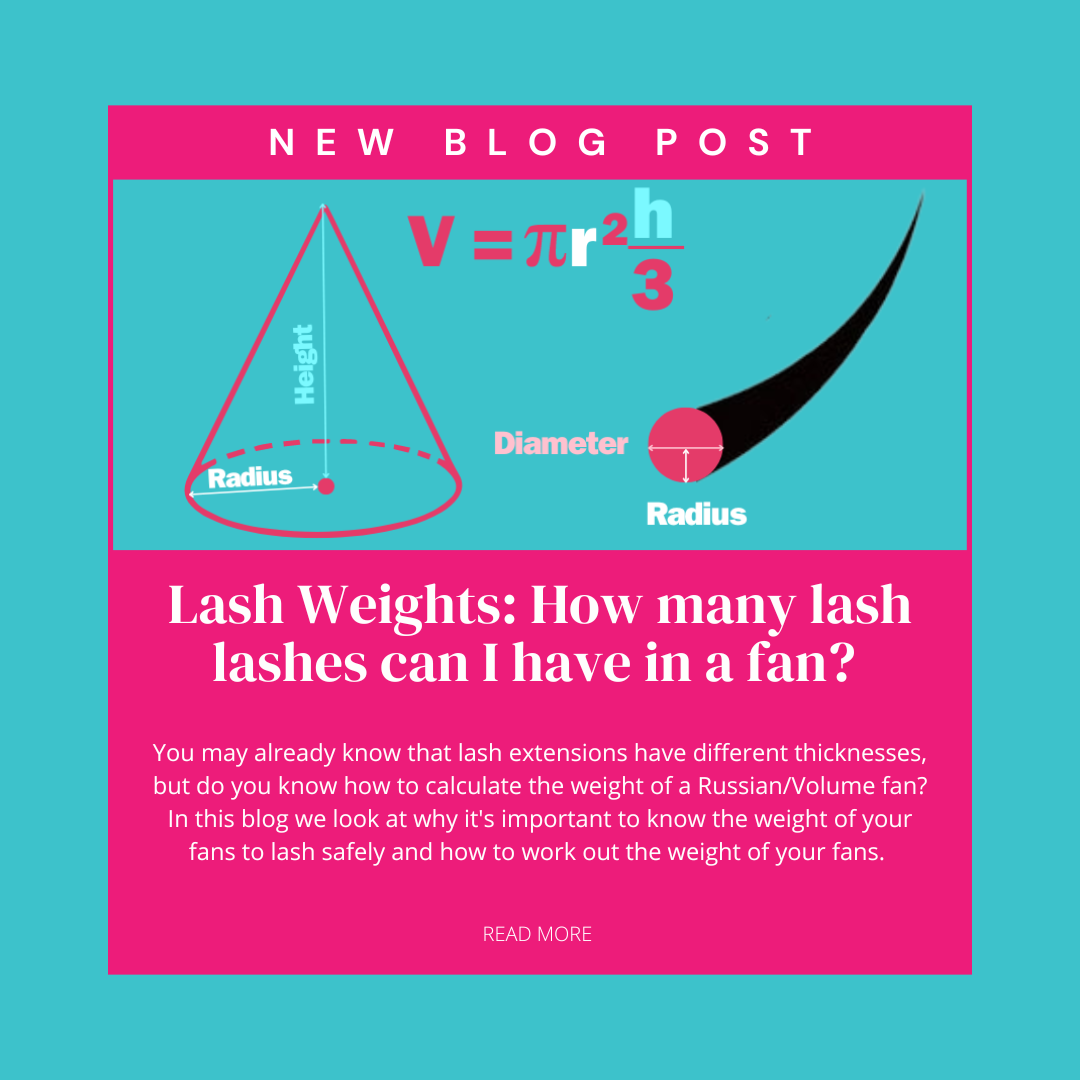You may already know that lash extensions have different thicknesses, but do you know how to calculate the weight of a Russian/Volume fan? In this blog we look at why it's important to know the weight of your fans to lash safely and how to work out the weight of your fans.
Why is it important to know lash weights?
All lash trays will have a thickness which refers to the diameter of the lash extension. The bigger the thickness the heavier the lash or the smaller the thickness the lighter the lash. This is important to know as many people get this part wrong and think that thicker lash extensions will give them more voluminous lashes, which is the case for classic extensions - but it's actually the opposite when it comes to fan making!
It is so important to know your lash thicknesses and weights as placing lash extensions that are too heavy can cause damage and breakage to the natural lash as well as discomfort and irritation for your client.
What lash thickness should I be using?
The best thickness to use will depend on various factors including the condition of your clients natural lashes, their desired look and length. Thickness does not equal weight so you can create different looks with different thicknesses. Here are some recommendations for which thickness to use depending on the condition of your clients natural lashes.
Thin Natural Lashes > = 0.10mm
Healthy Natural Lashes 0.15mm
Thick Natural Lashes 0.20mm
Here at Pinkfishes we offer in order of thickest to thinnest 0.25mm, 0.20mm, 0.15mm, 0.10mm, 0.07mm, 0.05mm and 0.03mm diameter lashes. We would only recommend using 0.15mm & 0.20mm thickness lashes for classic application (1:1) as these lashes will be too heavy for natural lashes to be made into fans. You can use 0.10mm, 0.07mm, 0.05mm & 0.03mm lashes to make Russian/Volume fans with as they are thinner and therefore lighter lashes. The thinner the thickness the more lashes you can have in a singular fan.

(0.03 Mega Volume Lash Extensions)
You can use Pinkfishes 0.03 thickness lashes to create mega volume sets like in the picture above. As mentioned these are the thinnest lashes we offer here at Pinkfishes so can be used to create fuller fans for darker more voluminous sets.

(0.05 Russian Lash Extensions)
(0.07 Russian Lash Extensions)
How do you calculate the weight of a lash extension?
Now this is the complicated bit where maths gets involved! Again a common misconception is that a 2D 0.10 fan = a 0.20 lash, but this is not true! This is because the circular cone like shape of the lash extension will mean their is negative space when directly compared, so a 2D 0.10 fan will actually be lighter than a 0.20 lash! The image below helps to explain this as you can see two 0.10 lashes placed into a 0.20 lash.
Lash weights are hard to precisely measure as they are very lightweight and the weight will be effected by the diameter and length so what we can do as an alternative is calculate the extension’s volumetric space, instead of it’s actual weight. To measure the volume of a lash extension we can take the mathematical formula of working out the volume of a cone, as lashes are a conical shape which shares similarities such as a circular base and pointed tip.

To calculate the volumetric weight use the following formula: Volume = Pi x (Radius Squared) x (Height/3). The radius can be calculated by dividing the diameter by 2. The height in this scenario will be the length of the lash extension for example 13mm. The diameter as mentioned earlier is the same as the thickness.

As an example to work out the volumetric weight of a D Curl 0.15 13mm lash you would do the following. The diameter is 0.15mm so to work out the radius you divide the diameter by 2 which would give you r = 0.075mm. Your height is the length of the lash extension so 13mm.
Volume= 3.14(0.075)² x 13, all divided by 3.
V=πr2h/3 = π·0.0752·13/3 ≈ 0.076576mm³
(Ps. A great tip is to use an online volume of cone calculator like this one: Volume of a Cone Calculator 📐 (gigacalculator.com)
How many lashes can you have in a lash extension fan?
Now you may be thinking that's great but how does this help me decide what lash extensions to use? You can use the volumetric weight of a classic lash to determine how many lashes you can have on a fan. For example if your client has healthy natural lashes you know their lashes could hold a 0.15 thickness lash. You can then work out the volumetric weight of the classic lash, in this example we will compare a 13mm 0.15 lash (V=πr2h/3 = π·0.0752·13/3 ≈ 0.076576mm³). Now that we know the volumetric weight of a 0.15 13mm lash is 0.076576mm³ we know that this is a healthy weight for the natural lash. You can then work out the volumetric weight of a Russian lash so for example a 0.05 13mm (V=πr2h/3 = π·0.025·13/3 ≈ 0.008508 mm3). If you then want to work out how many lashes can be in a fan safely, simply divide the volumetric weight of the classic lash by the volumetric weight of the Russian (0.076576/0.008508= 9.00047015 *always round down to make sure the lash is a safe weight) therefore in this example you could place '9' 0.05 13mm lashes on a fan and it would have the same weight as a 0.15 13mm lash.
Now we know this takes a lot of time so we don't expect you to sit and do this before each client, so here is a rough cheat sheet to the number of lashes you can have in a fan for thin, healthy and thick natural lashes;
Thin Natural Lashes
0.10 volumetric weight = π·0.05·13/3 = 0.034034 mm3
0.03 volumetric weight = π·0.015·13/3 = 0.003063mm3
(0.034034/0.003063 = 11.1113288) 11D fan using 0.03 would be the equivalent volumetric weight of a 0.10 classic lash.
0.05 volumetric weight = π·0.025·13/3 = 0.008508mm3
(0.034034/0.008508 = 4.00023507) 4D fan using 0.05 would be the equivalent volumetric weight of a 0.10 classic lash.
0.07 volumetric weight = π·0.035·13/3 = 0.016677mm3
(0.034034/0.016677 = 2.04077472) 2 fan using 0.07 would be the equivalent volumetric weight of a 0.10 classic lash

(Thin Natural Lashes number of fans example)
Healthy Natural Lashes
0.15 volumetric weight = π·0.0752·13/3 ≈ 0.076576mm³
0.03 volumetric weight = π·0.015·13/3 = 0.003063mm3
(0.076576/0.003063 = 25.0003265) 25D fan using 0.03 would be the equivalent volumetric weight of a 0.15 classic lash.
0.05 volumetric weight = π·0.025·13/3 = 0.008508mm3
(0.076576/0.008508 = 9.00047015) 9D fan using 0.05 would be the equivalent volumetric weight of a 0.15 classic lash.
0.07 volumetric weight = π·0.035·13/3 = 0.016677mm3
(0.076576/0.016677 = 4.59171314) 4D fan using 0.07 would be the equivalent volumetric weight of a 0.15 classic lash.
0.10 volumetric weight = π·0.05·13/3 = 0.034034 mm3
(0.076576/0.034034 = 2.24998531) 2D fan using 0.10 would be the equivalent volumetric weight of a 0.15 classic lash.
0.15
0.03 = 25D
0.05 = 9D
0.07 =4D
0.10 = 2D

(Healthy Natural Lashes number of fans example)
Thick Natural Lashes
The following is based on your client having really thick/strong natural lashes so the equivalent weight of 0.20.*Calculations have been based on using volumetric weight and length 13mm.
0.20 volumetric weight = π·0.10·13/3 ≈ 0.136136mm³
0.03 volumetric weight = π·0.015·13/3 = 0.003063mm3
(0.136136/0.003063 = 44.4453151) 44D fan using 0.03 would be the equivalent volumetric weight of a 0.20 classic lash.
0.05 volumetric weight = π·0.025·13/3 = 0.008508mm3
(0.136136/0.008508 = 16.0009403) 16D fan using 0.05 would be the equivalent volumetric weight of a 0.20 classic lash.
0.07 volumetric weight = π·0.035·13/3 = 0.016677mm3
(0.136136/0.016677 = 8.16309888) 8D fan using 0.07 would be the equivalent volumetric weight of a 0.20 classic lash.
0.10 volumetric weight = π·0.05·13/3 = 0.034034 mm3
(0.136136/0.034034 = 4) 4D fan using 0.10 would be the equivalent volumetric weight of a 0.20 classic lash.
0.20
0.03 = 44D*
0.05 = 16D
0.07 =8D
0.10 = 4D

(Strong Natural Lashes number of fans example)
*Please note:While the weight of the fan means that it would be safe to put 44 x 0.03 lashes into a fan on a healthy natural lash, this won't be very nice or comfortable for your clients' lash line. We always need to make sure we have a tight and pointy base when making a fan, so if this isn't achievable with the amount of lashes you are using, then you will need to reduce the amount of lashes you are putting in that fan.
We hope you have learnt why it is important to know the weight of the fans you are placing onto clients natural lashes, as well as how to calculate this and even use our cheat sheets in the future.
References
https://lashtrainer.com/lessons/lash-conversion-and-calculation/
https://www.bllashes.com/blogs/blog/how-to-calculate-volume-lash-size-weight
https://lashiivo.com/blogs/lashiivo-learning/understanding-lash-weights-and-conversions






